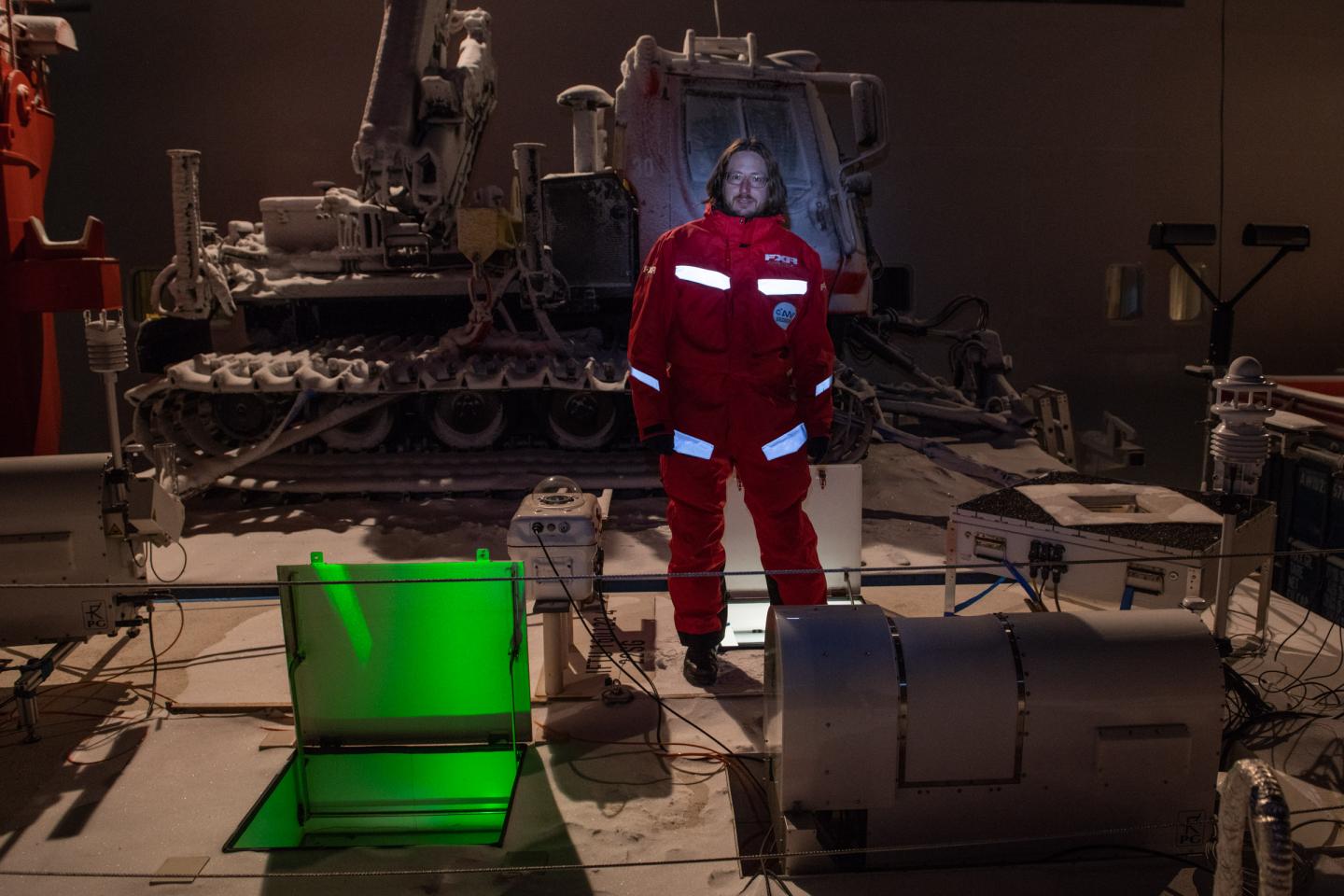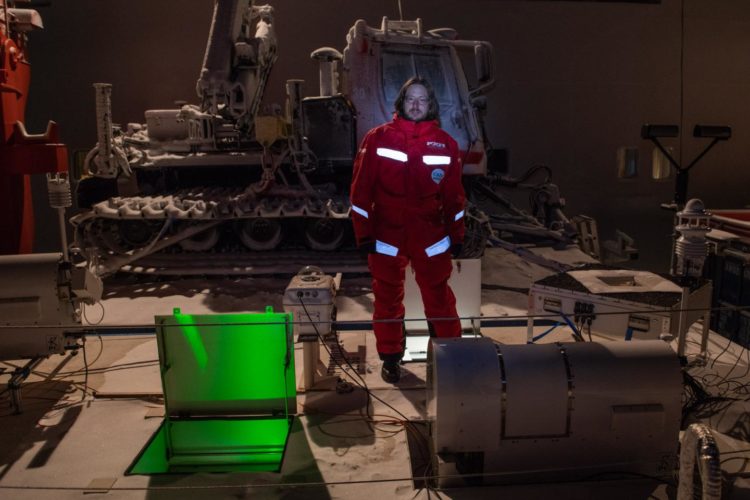For the first time during the MOSAiC expedition, a multi-wavelength lidar provides data on fine dust in the central Arctic during polar night.

Credit: Alfred-Wegener-Institut / Esther Horvath (CC-BY 4.0)
RV Polarstern (86°N,121°E). The atmosphere of the central Arctic is polluted with fine dust from Siberia and North America. This was the result of a preliminary evaluation of the first lidar measurements carried out by the Leibniz Institute for Tropospheric Research (TROPOS) during the one-year MOSAiC expedition on board of the RV Polarstern. For the first time, a multi-wavelength lidar was used during polar night in the central Arctic, which can measure dust particles at altitudes of up to 14 kilometres with laser pulses from the ground. First data show several layers of dust from human sources and forest fires at altitudes of 5, 6 and 12 kilometres. The data are an indication that the upper atmosphere of the region around the North Pole is more polluted in winter than previously assumed. In the coming months, the international MOSAiC expedition led by the Alfred Wegener Institute, the Helmholtz Centre for Polar and Marine Research (AWI), will provide data on climate change in the central Arctic, for which almost no measurements are available due to the extreme conditions of polar night.
On 4 October, the research vessel Polarstern reached the ice floe at 85°North and 137°East with which the icebreaker and an extensive measuring network on the ice intend to drift through the central Arctic at the North Pole for a year. With the official start of the MOSAiC expedition, the OCEANET container on board Polarstern also began its work. “Together with the containers of our US and Swiss partners, our container is located on the foredeck of RV Polarstern. I was able to put our laser into operation immediately after the end of the loading work. The aim is to measure the suspended particles in the atmosphere above the ship around the clock for a year,” reports Dr Ronny Engelmann of TROPOS, who is in charge of the measurements on board during the first leg of the voyage until he is replaced in December 2019.
Atmospheric research is thus breaking new ground: “The operation of our laser-based remote sensing system PollyXT in the central Arctic is unique to date. Never before the atmosphere in this remote region has been studied with a multi-wavelength lidar that works with light of different wavelengths from ultraviolet to infrared. Only with this combination is it possible to determine different suspended particles that can originate from various sources such as forest fires, volcanic ash, anthropogenic air pollution or the sea surface,” explains Dr Albert Ansmann, head of the ground-based remote sensing group at TROPOS.
For more than 20 years, TROPOS has been developing and operating lidar devices to investigate the properties of suspended particles, known as aerosols. These devices scan the atmosphere above the ground like a light radar with laser light and are therefore called lidars. Depending on the surface and shape of the particles, the laser light is reflected differently. If not only the transit time and quantity of the reflected light are measured, but also its polarization, then conclusions can be drawn about the properties of the particles. The team on RV Polarstern uses the latest generation of the mobile lidar system PollyXT, which emits laser pulses of ultraviolet (355 nanometers wavelength), green (532 nanometers wavelength) and infrared (1064 nanometers wavelength) light. It is received on 13 channels and thus covers a broad spectrum of light up to the infrared range. Since the ground-level air layers in the Arctic are particularly important for atmospheric research, it was equipped with a near-field channel to collect data from 50m above the ship to altitudes of 35 km. In addition, it measures with two fields of view in order to better detect the scattering of light in clouds. This dual-field-of-view technology, developed by TROPOS together with the National Academy of Sciences of Belarus, allows the determination of the size and number of cloud drops – an important parameter for climate models. Worldwide there are currently only two devices of this type. “The other device is located in our LACROS container in Punta Arenas, Chile, where we are studying the atmosphere near Antarctica at the southern tip of South America together with the Magellan University (UMAG) and the University of Leipzig in the DACAPO-PESO measurement campaign. Due to the identical structure, the data from both polar regions can be easily compared. We are looking forward to the results,” says Ansmann.
MOSAiC uses a large number of state-of-the-art measuring instruments which complement each other and together should provide a picture of the current climate in the region around the North Pole as complete as possible. “The Polly-XT laser-based system provides an unprecedented view of the vertical and temporal distribution of aerosol particles in the Arctic under a cloudless sky. Already on the morning of October 5, it cleared up and offered the laser an unobstructed view into the atmosphere. The observations yielded surprising results: The atmosphere at the remote site about 1000 kilometres north of Siberia was heavily polluted with suspended particles from the ground to a height of 12 kilometres. This pollution cannot come from local sources, but can only reach high latitudes via long-distance transport,” reports Dr Holger Baars, who contributes to the data evaluation at TROPOS in Leipzig. In order to limit the sources of air pollution in the Arctic, weather model simulations were evaluated and the origin of the air traced back over 10 days. “With the help of so-called backward trajectories, we can determine where the air measured above the ship comes from. It was shown that the air masses from southern Russia passed through southern Siberia at the edge of the Central Asian deserts via Kamchatka to the east before reaching the Arctic via Alaska. This matches the aerosol of forest fires, industrial pollution and desert dust that we see in the lidar data. And it fits the thesis that in polar winter the Arctic acts like a large vortex ‘sucking in’ air pollution from large parts of the northern hemisphere,” explains Martin Radenz of TROPOS, who created the air mass simulation.
Hardly any other region on earth has warmed as much as the Arctic in recent decades. Since 2016, the Transregio 172 “Arctic Climate Change” of the German Research Foundation (DFG) under the direction of the University of Leipzig has been investigating the role of clouds and the associated processes in the Arctic atmosphere. There were strong differences in the formation of ice in clouds depending on whether the clouds reach the ground or not. In fact, the TROPOS lidar measurements during the MOSAiC test campaign PASCAL in summer 2017 showed ice formation at surprisingly warm temperatures. “The fact that we find the warmest ice clouds in the Arctic initially seems paradoxical, but can perhaps be explained by a unique interplay of temperature, humidity and aerosol of biological origin,” says Prof. Andreas Macke, Director of TROPOS and chief scientist of the PASCAL expedition. Questions of cloud formation are the focus of the current investigations in order to find out how ice nucleating particles (INPs) influence cloud formation in the Arctic and how these in turn influence the observed warming.
MOSAiC stands for “Multidisciplinary drifting Observatory for the Study of Arctic Climate”. MOSAiC also includes about two dozen researchers from Leipzig. Both the Leibniz Institute for Tropospheric Research (TROPOS) and the University of Leipzig are on their way in the Arctic with elaborate instruments. The MOSAiC expedition led by the Alfred Wegener Institute, Helmholtz Centre for Polar and Marine Research (AWI), is associated with unprecedented challenges. MOSAiC has a budget of around 140 million euros. In the course of the year, approximately 300 scientists from 20 countries will be on board. Together, they want to explore the entire climate system in the Central Arctic for the first time. They will collect data in the five sub-areas of atmosphere, sea ice, ocean, ecosystem and biogeochemistry to understand the interactions that shape the Arctic climate and life in the Arctic Ocean.
The expedition to experience for all
News directly from the Arctic is available via the MOSAiC channels on Twitter (@MOSAiCArctic) and Instagram (@mosaic_expedition) via the Hashtags #MOSAiCexpedition, #Arctic and #icedrift. Further information on the expedition can be found at: http://www.
Current information on Leipzig’s participation in MOSAiC can be found at: https:/
MOSAiC and Lidar Measurements at the UN Climate Conference COP25
The MOSAiC expedition is also a topic at COP25 and part of two side events at the German Pavilion in Madrid: On 5 December in a session on climate change in the Arctic and on 12 December in a session on aerosol-cloud interactions.
###
Media contacts:
Participation of TROPOS in MOSAiC expedition:
Dr Albert Ansmann, Dr Holger Baars, Dr Patric Seifert, Dr Ronny Engelmann, Martin Radenz
Working Group “Ground Based Remote Sensing” at the Leibniz Institute for Tropospheric Research (TROPOS), Leipzig, Germany
Phone: +49-341-2717-7064, -7341, -7080, (-7315), -7369
https:/
https:/
https:/
https:/
https:/
and
Prof. Andreas Macke
Director, Leibniz Institute for Tropospheric Research (TROPOS), Leipzig, Germany
Phone: +49-341-2717-7060
https:/
or
Tilo Arnhold
Public Relations at the Leibniz Institute for Tropospheric Research (TROPOS), Leipzig, Germany
Phone: +49-341-2717-7189
https:/
MOSAiC expedition in general:
Ulrike Windhövel, Communications and Media Relations
Alfred Wegener Institute, Helmholtz Centre for Polar and Marine Research (AWI)
Phone: +49 471 4831-2008
and
Dr Katharina Weiss-Tuider, Communication officer MOSAiC
Alfred-Wegener-Institut, Helmholtz-Zentrum für Polar- und Meeresforschung
Phone: +49 331 288-2180
Email: [email protected]
https:/
Further information and links:
Lidar data from PollyArielle on RV Polarstern on PollyNet: http://polly.
(Due to scarce transmission capacities, only measurements of two days could be uploaded so far.)
Leipzig participation in MOSAiC
https:/
Digital logbook of the MOSAiC expedition with daily updates:
https:/
MOSAiC expedition (2019-2020):
https:/
dacapoPESO – Field experiment on clouds and precipitation under clean air conditions in southern Chile:
https:/
OCEANET: https:/
Multi-wavelength Raman and polarization lidar PollyXT:
https:/
dual-field-of-view (dual-FOV) Raman lidar technique:
https:/
Transregional Collaborative Research Centre TR 172 “Arctic amplification” – funded by the Deutsche Forschungsgemeinschaft – DFG: http://www.
Polarstern cruise PS106 (2017, in German): https:/
Media Contact
Tilo Arnhold
[email protected]
49-341-271-77189
Original Source
https:/





